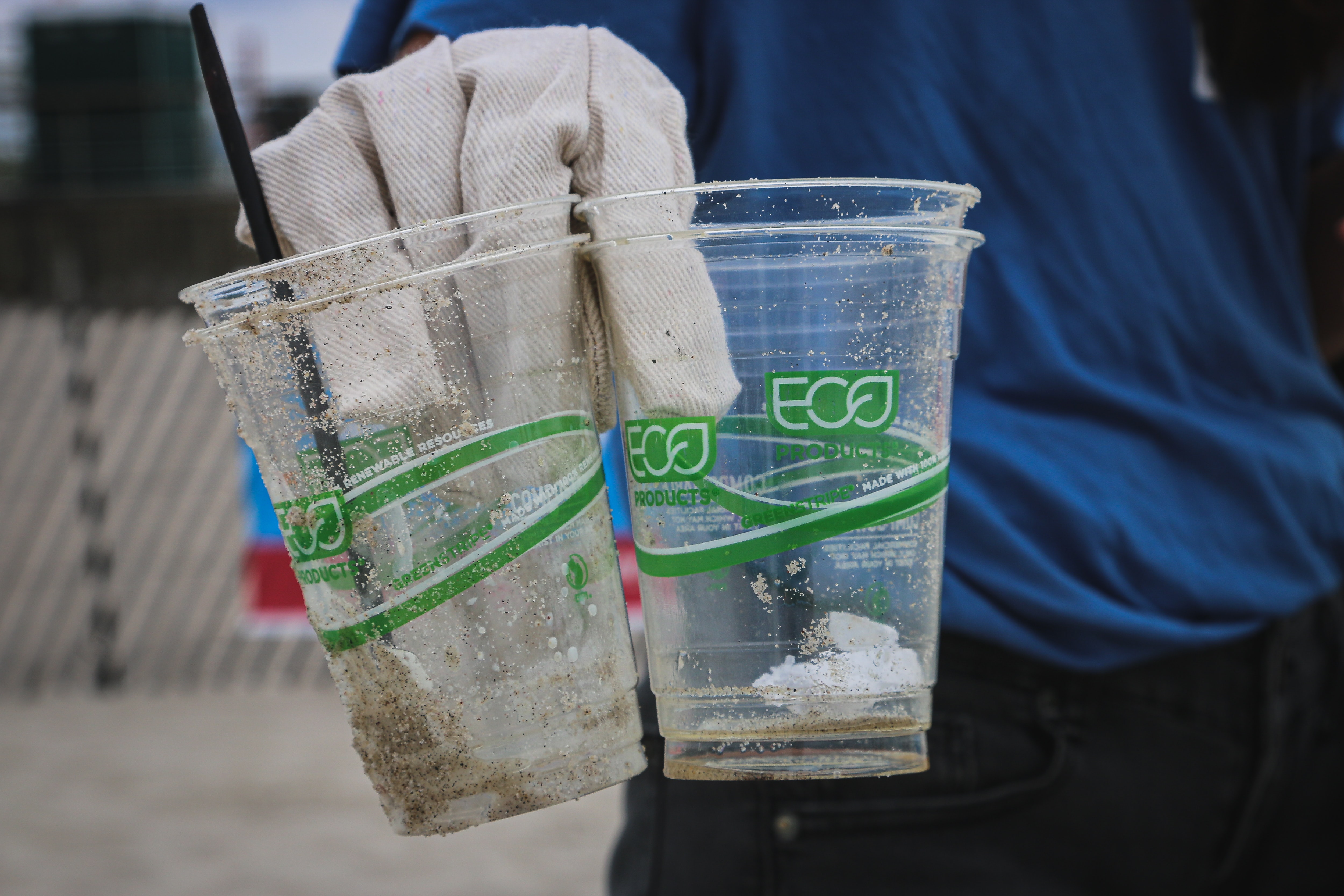Greenwashing vs Green Marketing (and Which One You Should Be Doing)

The words “sustainable”, “eco-friendly”, and “green” are being used today more than ever; and why wouldn’t they be?
There’s major money to be gained (and lost) depending on how green a company is perceived by its customers. Almost 70% of consumers prefer sustainable brands and are willing to pay a premium to support them.
Consumers are more conscious about environmental and global issues. Discussions (and arguments) are now a daily online occurrence, and international organizations like the United Nations are rallying entire nations to be more sustainable and socially responsible.
Among the desire and action for a more sustainable future, there’s also been a rise of companies that have noticed this trend and are using earnest movements simply for monetary gain; they misinform or misdirect in order to gain favor with consumers and investors alike. They’re tailoring their marketing material to appeal to those green-conscious consumers.
Rather than truly going green, they simply paint themselves green and advertise as such.
What is Greenwashing
Greenwashing is intentionally (or unintentionally) spending more time and resources on advertising sustainability rather than actually implementing environmentally friendly practices.
Simply put, it’s talking the talk without walking the walk.
It’s important to note that the definition refers to both intentional and unintentional actions of greenwashing, and this is an important point.
While it’s true that some corporations or businesses have less-than-benevolent intentions when they advertise their commitment to sustainability, other companies truly do have good intentions.
For companies that fall into the latter, greenwashing can occur simply due to a disconnect between committing to becoming more sustainable, and the efficacy of those actions towards sustainability.
It can be easy to overestimate the effectiveness of our sustainable actions, so it’s important to look at the things we’re doing through an honest lens.
Interested in learning how to avoid unintentional greenwashing or spot intentional greenwashing from others? Keep reading.
Who’s Guilty of Greenwashing?
Companies that claim to be ‘green’ only to appeal to a wider demographic are guilty of greenwashing, and this practice is nothing new in the marketing industry.
In fact, just one year before the first Earth Day in 1969, corporations spent more than 8 times on advertising anti-pollution ads than they did on anti-pollution research itself.
Unfortunately, the inception of Earth Day in 1970 only increased the amount of greenwashing amongst companies, and the practice has only become more sophisticated since.
McDonald's
McDonald's is infamous for launching a 'going green' campaign back in 2014 where they made a claim to source sustainable beef.
However, sustainability groups like Friends of the Earth, Animal Welfare Approved, Consumer Reports, and Food Chain Workers Alliance criticized these claims as they did not address many issues in the beef industry, and provided no specific or measurable performance standards.
(Source: https://blogs.ubc.ca/phoebechen/2010/11/18/logos-carry-missions/)
Volkswagen
Volkswagen is another major corporation that’s been found guilty of greenwashing in what’s now known as the ‘The Volkswagen Emissions Scandal’ and the ‘Diesel Dupe’.
In 2015, Volkswagen made substantial claims debunking the fact that diesel was bad for the environment while promoting ‘Clean Diesel’.
They stated that their cars utilized special technology to limit pollutants. To back up the claim, their cars underwent emissions testing which, after passing, proved that they were fully compliant with all federal emissions levels.
It was later discovered, however, that Volkswagen had installed ‘defeat devices’ which allowed the cars to cheat emission tests.
These devices would detect when the car was undergoing an emissions test and would alter the car’s performance to produce significantly fewer emissions. When operating normally, these cars would emit up to 40 times more nitrogen-oxide emissions (NOx) than the federal limit.
Needless to say, Volkswagen received immense backlash from the public and was responsible for a $14.7 billion settlement. Volkswagen would also have to offer a $10 million buyback program to those who purchased cars that had these ‘defeat devices' installed.
This act of greenwashing and deception not only cost them money but also cost them their reputation and consumers’ confidence in the Volkswagen brand.
What is Green Marketing?
Greenwashing should not be confused with green marketing, however, which is the act of transparently advertising legitimate and verifiable green claims.
This can include promoting sustainable products, drawing attention to relevant environmental issues, or advertising eco-friendly company initiatives.
Companies that greenmarket effectively advertise and inform the public about the sustainable actions that they’re doing and committing to do in the future, keeping their consumers in the loop.
While it seems obvious that marketing claims should be factual, many companies, whether intentional or not, still seem to favor greenwashing techniques. A 2017 study that investigated over 5000 home products found that a shocking 95% of them had misrepresentative sustainability claims.
Whereas greenwashing is when a company is less sustainable than they claim to be, green marketing is when a company truly is pursuing sustainable and green endeavors and advertises truthfully.
What does effective green marketing look like?
Patagonia and Green Marketing
Patagonia is a company that is almost synonymous with 'outdoors', but they’re also a terrific example of effective green marketing.
The company has taken considerable measures to produce more eco-friendly products. They use cotton that’s certified organic by the Global Organic Textile Standard (GOTS) and use a substantial amount of recycled fabrics.
Patagonia encourages consumers not to buy more articles of clothing than necessary and openly rejects fast fashion by producing high-quality and durable products. They’ve even launched a campaign to encourage consumers to not buy a jacket from them in an attempt to decrease consumer waste.
They also donate millions each year to supporting sustainable agriculture practices.
What’s most commendable, however, is the fact that they are extremely transparent with their shortcomings as well, and have admitted that their shell coats are made of nonrenewable fossil fuels. All these things combined make Patagonia a shining example of green marketing done right.
(Source: https://thegreenmarketoracle.com/2013/10/24/patagonia-may-be-worlds-most/ )
Simply put, greenwashing only aims to attract more customers through utilizing false or vague green claims.
Green marketing instead focuses on advertising genuine eco-friendly practices while providing clarity and specific measurable standards.
The Negative Effects of Greenwashing
Loss of Consumer Confidence
Greenwashing makes consumers lose faith in your company, and distrust future marketing content you release.
Companies that demonstrate a commitment to sustainability are outperforming those that don't, so it's no surprise that companies have taken advantage of this trend. However, consumers are more conscious about brand transparency than ever. According to U.S. findings, 85% of consumers would avoid using the brands they have lost trust in ever again.
Greenwashing can have serious implications on your company, now and in the future.
While it may seem like a quick and easy add-on to bring in more customers, it will likely result in the opposite.
Potential Lawsuits
Greenwashing has led to multiple lawsuits, some of which have resulted in companies paying substantial sums of money.
In 2017, Walmart had to pay $1 million to settle a greenwashing lawsuit over misleading labels.
It’s not hard to find more examples of legal actions taken against misleading green claims, and in some cases, they can have a lasting, devastating, impact on the company.
The 7 Sins of Greenwashing
The 7 Sins of Greenwashing are specific actions that have been identified as being particularly problematic in the way of marketing sustainability.
In 2007, TerraChoice (which has since been acquired by UL) investigated environmental claims made by organizations on leading brands and products in an attempt to categorize and quantify greenwashing.
From the study, they developed the 7 Sins of Greenwashing and found that a frightening 98% of the products they studied were guilty of committing at least one of the sins listed below.
Can you think of a company or brand that’s guilty of one or more of these?
(Source: https://www.ecowatch.com/7-sins-of-greenwashing-and-5-ways-to-keep-it-out-of-your-life-1881898598.html )
1. Hidden Trade-Off
Hidden trade-offs are when a company will label a product as sustainable and environmentally friendly based exclusively on a specific set of attributes.
This labeling, however, ignores other aspects of the product, and the negative effects of these aspects may outweigh the eco-friendly positives.
An example would be labeling a product as ‘made from recycled materials’ while that product is produced in a factory that emits harmful levels of gas. The claim may be true, but harmful and hidden production procedures still make the product unsustainable.
2. No Proof
Providing no proof is pretty straightforward.
Making an environmental claim without properly supporting that claim through credentials or evidence. An example of this would be advertising beef as being raised in cruelty-free environments without proper certifications, like Animal Welfare Approval (AWA).
3. Vagueness
Vagueness occurs when products are marketed with terms that are nonspecific and over-generalized.
These terms are often too broad to be properly understood and are likely to be misconstrued by consumers.
There are many examples of this, one being the use of the term 'all-natural.' This term does evoke a sense of sustainability, but in reality, there are many naturally occurring compounds that are dangerous for both the environment and individuals.
4. Irrelevance
Irrelevance can happen when products are marketed with environmental claims that may be true but do not actually assist consumers in seeking out eco-friendly products.
Common examples of this are products that are labeled as “CFC-Free” (Chlorofluorocarbon-free).
This may sound impressive, but CFC’s are legally banned, making this claim entirely irrelevant for consumers who want to seek out sustainable options.
5. Lesser of Two Evils
When it comes to greenwashing, claiming to be the lesser of two evils is still not considered eco-friendly.
Having a product that is greener than competitors in a category that is known to be unsustainable does not make that product green.
Organic cigarettes are still extremely bad for the environment (and for your health).
6. Fibbing
Fibbing is simply when a company makes false claims. This can involve providing falsified statistics to make a product look more green, or even spreading misinformation regarding sustainability and the practices of the company.
7. Worshiping False Labels
Worshipping false labels can be difficult for consumers to spot, as some companies will award their products with false labels that claim to be backed by third parties.
Some companies have even gone as far as to create their own green label that they then bestow upon their own products without any proper regulation.
This can also include using images or symbols that resemble real certifications in order to trick consumers into thinking they're making a sustainable or healthy purchase.
How to Avoid Greenwashing
Here are a few ways to avoid committing the sins of greenwashing.
Not all of these recommendations are required to avoid greenwashing, but any combination of these will all certainly help. And the more that you do, the greater it will improve the brand trust and loyalty consumers feel towards your company.
Gather Reliable Credentials
Ensure that your claims and statements can be backed up by official and reliable third parties.
Seek out authentic credentials that will leave your buyers with zero doubts that the certification they see is one they can trust; it’ll increase both your company's credibility and reliability.
Consumers want to see certification labels that they know and trust. A study in 2014 showed that 54% of consumers feel most reassured about a company's sustainability when they see a certified label.
Some widely known credentials include certified B-Corps or AWA (Animal Welfare Approved). You can check out all the ecolabels in Canada here.
Connect Sustainability to Your Brand Equity
Integrating sustainability into your brand equity will help assure consumers that your eco-friendly advertisements aren’t just for show.
Instead of marketing specific products as green, work to have sustainability embedded into the image of your brand.
Consider integrating eco-friendly messages into your value propositions or mission statements. You can also showcase your green initiatives and certifications in places other than just your products; feature them on your website and other promotional material.
It's also helpful to use photos and videos of your company's green initiatives in promotional materials to help further cement your brand's relationship with sustainability.
Perform Business-Wide Green Initiatives
Sustainability starts from within. Practicing sustainability internally will result in a more sustainable company overall.
Getting your employees to practice sustainability in their work life, will instill a culture of sustainability within your company, which will undoubtedly transfer over to their professional endeavors.
Encouraging staff to recycle or promoting a paperless office are small things you can do that can have a big impact on how your company perceives sustainability. This can all be connected to corporate giving and will signal to both stakeholders and consumers that your company cares about making social and environmental change.
Lastly, don’t underestimate the power of word-of-mouth green marketing. Employees that feel proud of their sustainably-centered workplace will often speak highly of the company and brand when discussing it with those closest to them.
Give Back
You can even take it one step further and encourage employees to give back to communities through things like volunteering.
Consider implementing employee volunteering programs that make it easy for your employees to volunteer their time to causes that matter to them. Bonus points if you can create one without the hassle of searching for opportunities on their own (or with extra work for the HR department).
If implementing an employee volunteer program seems out of reach for your company, there are lots of resources and programs that can help with this; it’s often easier than you think.
Like performing business-wide initiatives, giving back can serve to increase corporate giving and show the public that your company is willing to go the extra mile to achieve social change.
Be Transparent
Most importantly, be transparent about your sustainability commitments, plans, and actions, and about the steps you'll take to accomplish them.
If you take only one piece of advice from this list, do this.
It's the simplest way to build a trusting relationship with your consumers while actively avoiding greenwashing. Customers don’t want to feel like they’re in the dark or they’re being lied to.
Try setting public goals and deadlines. This way your customers can hold you accountable; it’ll also ensure public expectations are properly managed.
Be transparent not only about your eco-friendly actions and aspirations but also about your shortcomings.
Clearly state areas where your company is, where it’s going, and what level of sustainability may be unachievable for your company. This can give you plausible deniability and ensure that you don't face the backlash of greenwashing.
Consumers will appreciate you being realistic about your commitments, and treating them honestly and respectfully.
Conclusion
Advertising and boasting about your company's green initiatives is not a bad thing, in fact, we think it's something you should market heavily.
Consumers are willing to pay for sustainable products and brands, and your company should reap the benefits of the hard work (and resources) that you’re investing into being a sustainable business. But only if what you’re saying is truly what you're doing.
Don’t use false claims in your green marketing and fall victim to being accused of greenwashing, especially in an era where consumers are boycotting brands that don't meet their environmental expectations more than ever before.
Remember that sustainability is more than just a trend, and its importance will only increase as time goes on. Get ahead of the competition by practicing proper green marketing habits and positioning your brand as a leader in sustainability.
Sign up to our newsletter (bottom of the page) to get the best articles and news sent directly to your inbox.
Do you know someone that could benefit from this article? Share it with them!
Did we miss anything in this article? Let us know below!


